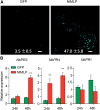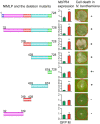A Mucin-Like Protein of Planthopper Is Required for Feeding and Induces Immunity Response in Plants
- PMID: 29133370
- PMCID: PMC5761773
- DOI: 10.1104/pp.17.00755
A Mucin-Like Protein of Planthopper Is Required for Feeding and Induces Immunity Response in Plants
Abstract
The brown planthopper, Nilaparvata lugens, is a pest that threatens rice (Oryza sativa) production worldwide. While feeding on rice plants, planthoppers secrete saliva, which plays crucial roles in nutrient ingestion and modulating plant defense responses, although the specific functions of salivary proteins remain largely unknown. We identified an N. lugens-secreted mucin-like protein (NlMLP) by transcriptome and proteome analyses and characterized its function, both in brown planthopper and in plants. NlMLP is highly expressed in salivary glands and is secreted into rice during feeding. Inhibition of NlMLP expression in planthoppers disturbs the formation of salivary sheaths, thereby reducing their performance. In plants, NlMLP induces cell death, the expression of defense-related genes, and callose deposition. These defense responses are related to Ca2+ mobilization and the MEK2 MAP kinase and jasmonic acid signaling pathways. The active region of NlMLP that elicits plant responses is located in its carboxyl terminus. Our work provides a detailed characterization of a salivary protein from a piercing-sucking insect other than aphids. Our finding that the protein functions in plant immune responses offers new insights into the mechanism underlying interactions between plants and herbivorous insects.
© 2018 American Society of Plant Biologists. All Rights Reserved.
Figures






Similar articles
-
Planthopper protein Nlsp5 is essential for salivary sheath formation and acts as a HAMP inducing plant resistance to insects.Plant Biotechnol J. 2025 Sep;23(9):4076-4091. doi: 10.1111/pbi.70223. Epub 2025 Jun 23. Plant Biotechnol J. 2025. PMID: 40546084 Free PMC article.
-
A salivary EF-hand calcium-binding protein of the brown planthopper Nilaparvata lugens functions as an effector for defense responses in rice.Sci Rep. 2017 Jan 18;7:40498. doi: 10.1038/srep40498. Sci Rep. 2017. PMID: 28098179 Free PMC article.
-
An Insect Salivary Sheath Protein Triggers Plant Resistance to Insects and Pathogens as a Conserved HAMP.Adv Sci (Weinh). 2025 Jun;12(21):e2415474. doi: 10.1002/advs.202415474. Epub 2025 Apr 1. Adv Sci (Weinh). 2025. PMID: 40167256 Free PMC article.
-
The Roles of Phytohormones in Plant Defense Mechanisms Against the Brown Planthopper.Genes (Basel). 2024 Dec 8;15(12):1579. doi: 10.3390/genes15121579. Genes (Basel). 2024. PMID: 39766846 Free PMC article. Review.
-
Genetic and biochemical mechanisms of rice resistance to planthopper.Plant Cell Rep. 2016 Aug;35(8):1559-72. doi: 10.1007/s00299-016-1962-6. Epub 2016 Mar 15. Plant Cell Rep. 2016. PMID: 26979747 Review.
Cited by
-
The roles of small RNAs in rice-brown planthopper interactions.Front Plant Sci. 2023 Nov 23;14:1326726. doi: 10.3389/fpls.2023.1326726. eCollection 2023. Front Plant Sci. 2023. PMID: 38078088 Free PMC article. Review.
-
Plant elicitor peptide signalling confers rice resistance to piercing-sucking insect herbivores and pathogens.Plant Biotechnol J. 2022 May;20(5):991-1005. doi: 10.1111/pbi.13781. Epub 2022 Feb 18. Plant Biotechnol J. 2022. PMID: 35068048 Free PMC article.
-
Advances of herbivore-secreted elicitors and effectors in plant-insect interactions.Front Plant Sci. 2023 Jun 19;14:1176048. doi: 10.3389/fpls.2023.1176048. eCollection 2023. Front Plant Sci. 2023. PMID: 37404545 Free PMC article. Review.
-
Planthopper-Secreted Salivary Disulfide Isomerase Activates Immune Responses in Plants.Front Plant Sci. 2021 Jan 18;11:622513. doi: 10.3389/fpls.2020.622513. eCollection 2020. Front Plant Sci. 2021. PMID: 33537052 Free PMC article.
-
Endosymbiotic Fungal Diversity and Dynamics of the Brown Planthopper across Developmental Stages, Tissues, and Sexes Revealed Using Circular Consensus Sequencing.Insects. 2024 Jan 29;15(2):87. doi: 10.3390/insects15020087. Insects. 2024. PMID: 38392507 Free PMC article.
References
-
- Atamian HS, Chaudhary R, Cin VD, Bao E, Girke T, Kaloshian I (2013) In planta expression or delivery of potato aphid Macrosiphum euphorbiae effectors Me10 and Me23 enhances aphid fecundity. Mol Plant Microbe Interact 26: 67–74 - PubMed
-
- Axelsson MA, Asker N, Hansson GC (1998) O-Glycosylated MUC2 monomer and dimer from LS 174T cells are water-soluble, whereas larger MUC2 species formed early during biosynthesis are insoluble and contain nonreducible intermolecular bonds. J Biol Chem 273: 18864–18870 - PubMed
-
- Backus EA, Serrano MS, Ranger CM (2005) Mechanisms of hopperburn: an overview of insect taxonomy, behavior, and physiology. Annu Rev Entomol 50: 125–151 - PubMed
-
- Bonaventure G. (2012) Perception of insect feeding by plants. Plant Biol (Stuttg) 14: 872–880 - PubMed
Publication types
MeSH terms
Substances
LinkOut - more resources
Full Text Sources
Other Literature Sources
Miscellaneous

